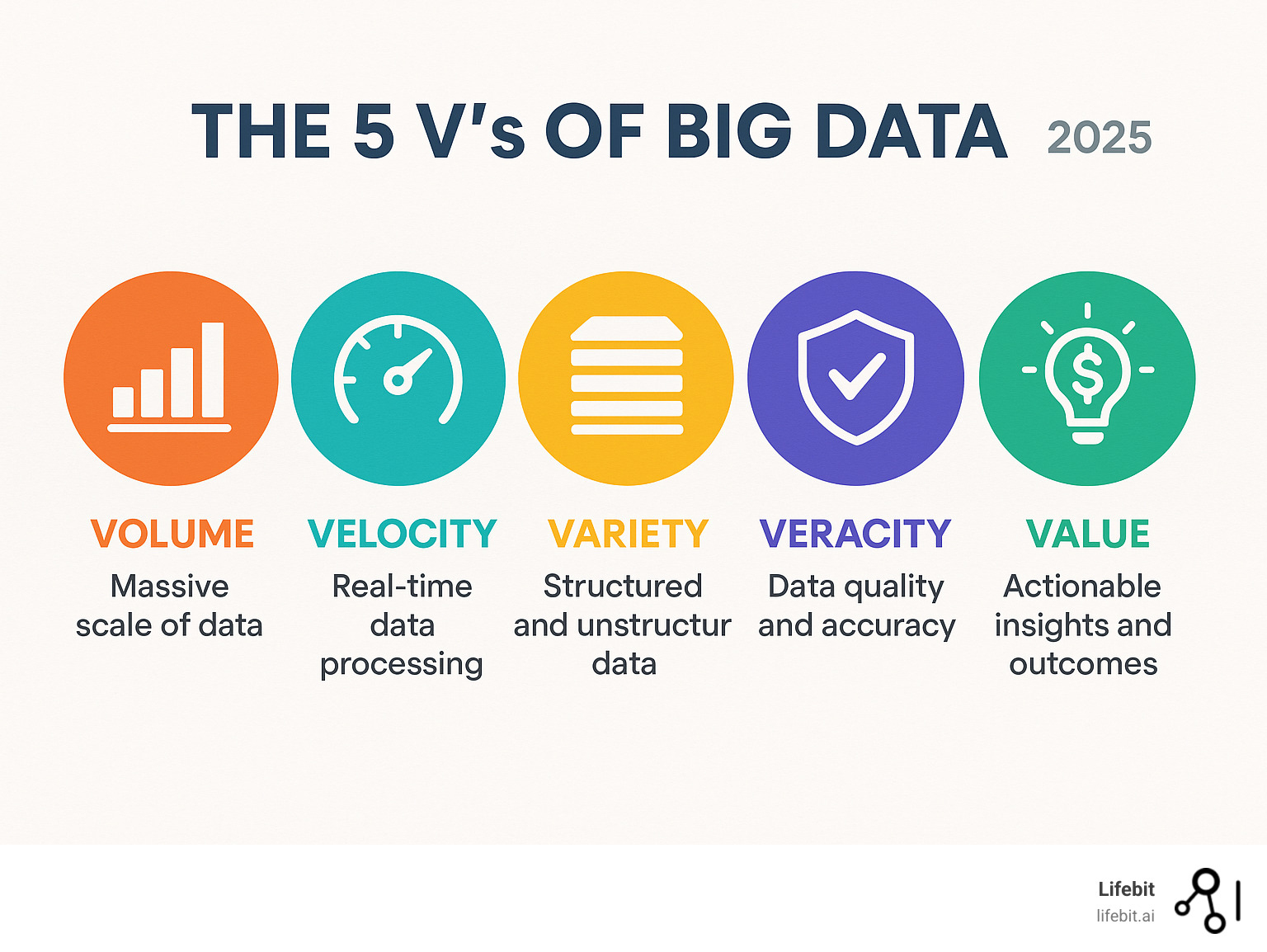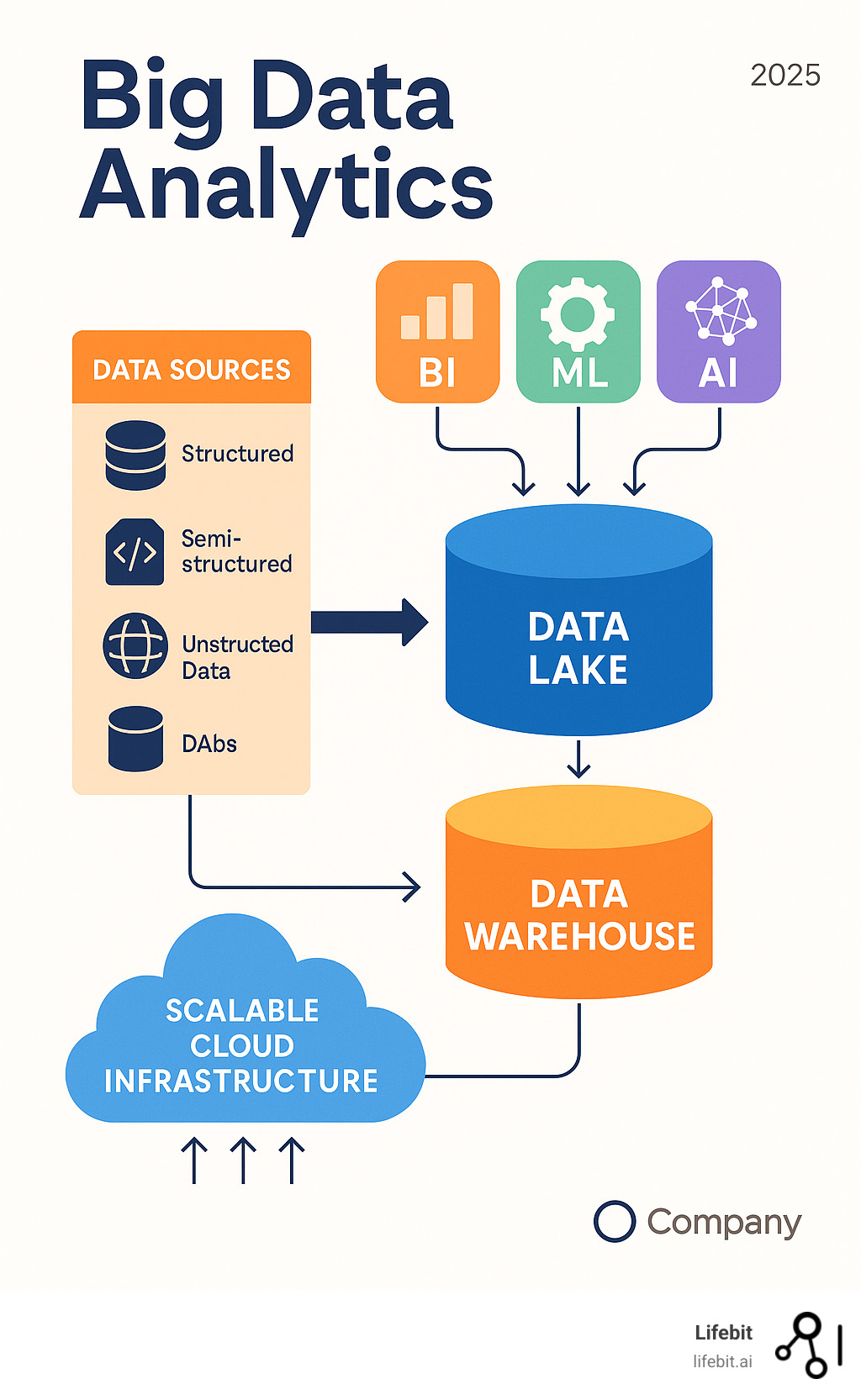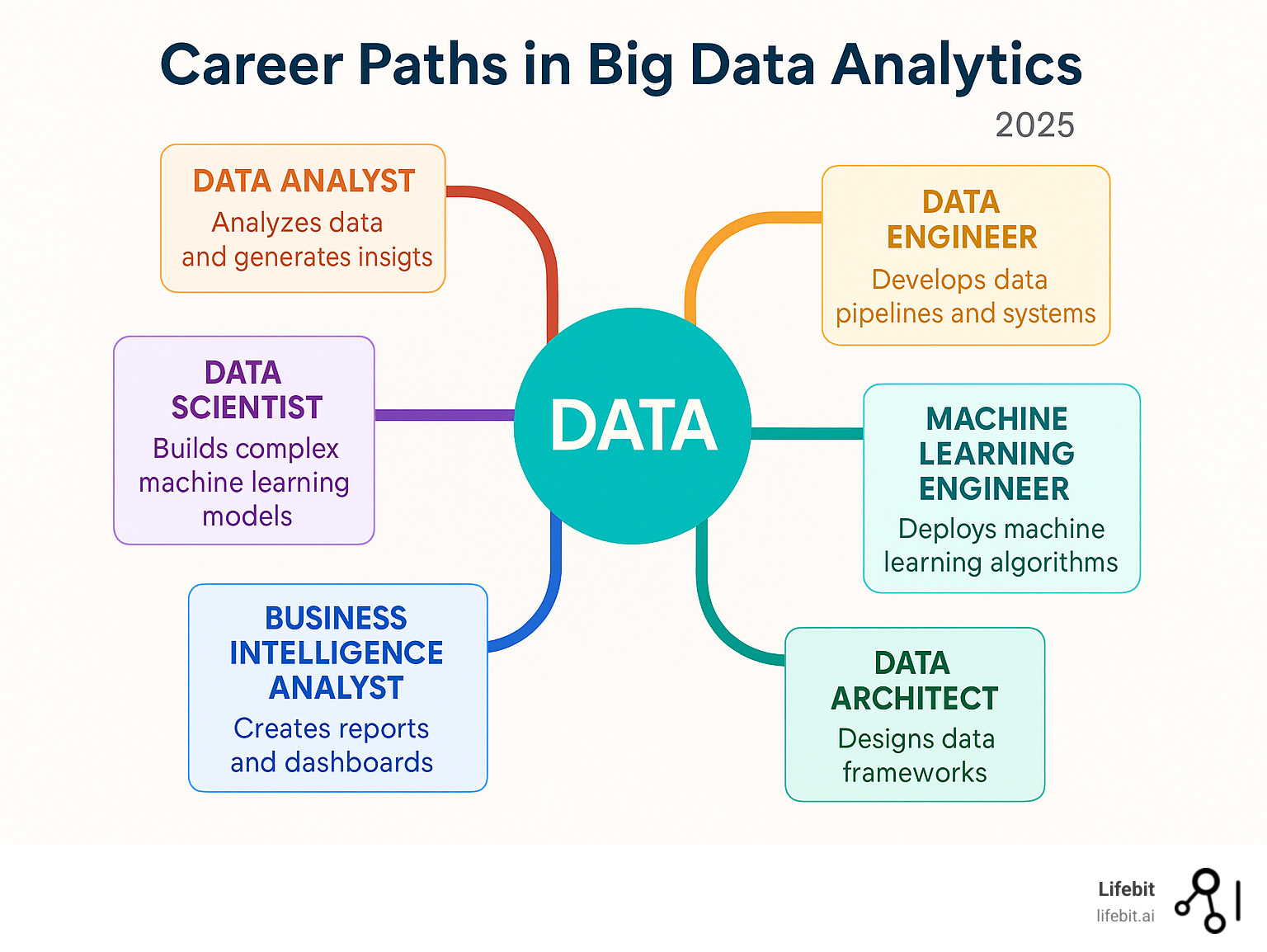Beyond the Hype: Demystifying Big Data Analytics

Big data analytics: Demystify 4 Core Types
Why Big Data Analytics Is Changing Modern Organizations
Big data analytics is the process of examining large, complex datasets to uncover hidden patterns, trends, and insights that drive better business decisions. Here’s what you need to know:
- Definition: Advanced analysis of massive, diverse datasets using specialized tools and techniques.
- Core Components: The 5 V’s – Volume, Velocity, Variety, Veracity, and Value.
- Types: Descriptive (what happened), Diagnostic (why), Predictive (what will happen), and Prescriptive (what to do).
- Benefits: Cost reduction, improved efficiency, competitive advantage, and data-driven innovation.
- Applications: Healthcare, finance, retail, manufacturing, and government sectors.
Every day, organizations generate massive amounts of data from customer interactions, sensor readings, and financial transactions. This data comes from every touchpoint: emails, mobile apps, social media, online purchases, and customer service chats.
The challenge isn’t just collecting this data—it’s turning it into actionable insights. Traditional analytics tools often can’t handle the volume, speed, and complexity of today’s data landscape.
Big data analytics transforms this challenge into an opportunity. It enables organizations to move beyond gut feelings to evidence-based strategies that deliver measurable results.
I’m Maria Chatzou Dunford, CEO and Co-founder of Lifebit. With over 15 years applying big data analytics to genomics and biomedical research, I have deep experience in turning complex, federated data into powerful insights.

What is Big Data and Why Does It Matter?
Big data analytics is the systematic process of examining massive, complex datasets to extract valuable insights that drive smarter business decisions. Unlike traditional analytics, it tackles the messy reality of modern information—from customer tweets and sensor readings to medical images and financial transactions, all flowing in at breakneck speed.
Uncovering hidden patterns and correlations within this vast sea of information gives organizations a significant competitive advantage, turning raw data into strategic assets. This isn’t just about having more data; it’s about using advanced techniques to understand what it means and how to act on it.
The 5 V’s define what makes data “big”:
- Volume: The sheer scale of information. We’ve moved beyond gigabytes to terabytes, petabytes, and even exabytes. To put a petabyte in perspective, it’s equivalent to over 13 years of continuous HD video. Organizations must manage this immense volume, which is often generated by machines, networks, and human interactions on social media.
- Velocity: The lightning-fast speed at which data streams in, requiring real-time or near-real-time processing. Think of stock market data, social media trends, or GPS signals from a fleet of delivery trucks. The value of this data often diminishes quickly, so it must be analyzed as it’s created to enable immediate action, like flagging a fraudulent transaction.
- Variety: The diverse formats of data. Traditional analytics focused on structured data that fits neatly into rows and columns, like sales records in a database. Big data also encompasses unstructured data (videos, audio files, emails, social media posts) and semi-structured data (JSON files, XML logs). Harnessing this variety provides a more complete picture.
- Veracity: The quality and trustworthiness of the data. With data coming from so many sources, it’s often messy, inconsistent, and contains inaccuracies. Veracity involves managing this uncertainty, cleaning the data, and ensuring that the insights derived from it are reliable. Poor veracity leads to flawed conclusions and misguided strategies.
- Value: The ultimate goal of collecting and analyzing big data. Data has no inherent worth; its value is unlocked through analysis that leads to actionable insights. This could mean identifying a new market opportunity, optimizing a supply chain to save millions, or personalizing a customer experience to boost loyalty. If the analysis doesn’t drive a valuable outcome, it’s just an academic exercise.
The technology revolution of the early 2000s, driven by advances in distributed computing and the falling cost of storage, made it possible to store and process these massive datasets. Open-source frameworks like Hadoop allowed organizations to use clusters of commodity hardware to analyze data at a scale that was previously only possible for supercomputers.
Traditional analytics tools simply cannot cope with this new reality. The table below highlights the key differences.
| Feature | Traditional Data Analytics | Big Data Analytics |
|---|---|---|
| Data Volume | Smaller, manageable datasets (megabytes, gigabytes) | Massive datasets (terabytes, petabytes, exabytes) |
| Data Velocity | Batch processing; Data analyzed after collection | Real-time processing; Data analyzed as it streams |
| Data Variety | Primarily structured data (e.g., relational databases) | Structured, semi-structured, and unstructured data |
| Tools Used | SQL databases, spreadsheets, traditional BI tools | Hadoop, Spark, NoSQL databases, advanced ML/AI platforms |
| Analytical Focus | Retrospective (what happened) | Predictive and prescriptive (what will happen, what to do) |
| Complexity | Lower complexity, well-defined schemas | High complexity, dynamic schemas, diverse data sources |
| Insights Gained | Standard reports, historical trends | Hidden patterns, predictive models, actionable recommendations |
Looking ahead, McKinsey & Company predicts that the data-driven enterprise of 2025 will use data as the foundation for nearly every aspect of its operations. This isn’t just about staying competitive; it’s about fundamentally reshaping how organizations operate by turning the data deluge into a strategic advantage.
The Four Types of Analytics
Think of big data analytics as a staircase of increasing value and complexity, where each step provides a clearer view of your business. Each type of analytics builds on the previous one, moving you from basic reporting to sophisticated, automated decision-making. Most organizations start at the bottom and work their way up as their data capabilities mature.
Descriptive Analytics: What Happened?
Descriptive analytics is the foundation of data analysis, summarizing past data to create a clear, high-level picture of what happened. It’s the most common form of analytics, used to track Key Performance Indicators (KPIs) and generate standard reports. You’re likely familiar with this through business intelligence tools like Tableau or Power BI, which create dashboards showing monthly sales figures, website traffic sources, or social media engagement metrics. For example, a retail company might use descriptive analytics to see which products were the top sellers last quarter. A facilities manager could review office usage data to identify underutilized real estate and consolidate spaces to save millions.
Diagnostic Analytics: Why Did It Happen?
Once you know what happened, diagnostic analytics helps you understand the root cause. This approach goes deeper than descriptive reports by using techniques like data mining, drill-down, and root cause analysis to find dependencies and patterns. For instance, if an e-commerce site’s sales drop unexpectedly (the what), diagnostic analytics can investigate further. Analysts might drill down into the data to discover the drop was isolated to mobile users on a specific operating system. Further analysis could pinpoint the cause: a recent app update introduced a bug in the payment page, preventing those users from completing purchases. This distinguishes a technical issue from a broader market trend.
Predictive Analytics: What Will Happen?
Predictive analytics uses historical data, statistical algorithms, and machine learning models to forecast future trends and outcomes. Instead of just reacting to the past, you can proactively anticipate what’s coming next. This is where data science becomes a powerful strategic tool. Common techniques include regression analysis to predict a continuous value (like future revenue) and classification models to predict a category (like whether a customer will churn). In manufacturing, predictive analytics uses sensor data to forecast equipment failures. This allows for proactive predictive maintenance, preventing costly downtime by scheduling repairs before a breakdown occurs. Financial institutions use it to predict credit risk, and retailers use it to forecast demand for inventory management.
Prescriptive Analytics: What Should We Do?
At the top of the staircase, prescriptive analytics recommends the best course of action to achieve a desired outcome. It’s the most advanced form of analytics, using AI-driven decisions, simulations, and optimization algorithms to weigh countless variables and suggest optimal solutions. While predictive analytics tells you what’s likely to happen, prescriptive analytics tells you what to do about it. Airlines use prescriptive analytics for dynamic pricing models. Algorithms don’t just predict demand; they recommend the optimal ticket price in real-time based on demand, weather, competitor pricing, and remaining seat capacity to maximize revenue. Similarly, a logistics company can use it to dynamically reroute its delivery fleet based on live traffic and weather data, ensuring on-time deliveries while minimizing fuel consumption. This enables real-time adjustments that are far too complex for humans to calculate manually.
The Big Data Analytics Process and Technology Stack
Transforming raw data into business insights requires a well-orchestrated process supported by a powerful technology stack. Understanding this end-to-end workflow is essential for any organization aiming to build a sustainable data-driven culture.
The Core Workflow of Big Data Analytics
The journey from data to decisions follows a systematic, cyclical path:
- Data Collection: Information is gathered from a wide array of sources. This includes internal sources like CRM and ERP systems, transactional data, and machine-generated data like server logs and IoT sensor readings. It also includes external sources like social media feeds, public APIs, and third-party datasets.
- Data Processing: Collected raw data is sorted and prepared for analysis. This step often involves ETL (Extract, Transform, Load) or ELT (Extract, Load, Transform) pipelines. Stream processing handles urgent, time-sensitive data in real-time (e.g., fraud alerts), while batch processing is used for large volumes of less time-sensitive data (e.g., daily sales reporting).
- Data Cleaning: This is a crucial step to ensure data quality, as the principle of “garbage in, garbage out” applies. It involves handling missing values through imputation, correcting errors, removing duplicate records, and identifying and managing outliers. Poor data quality is one of the biggest barriers to successful analytics, leading to unreliable insights and poor decisions.
- Data Analysis: This is where insights are uncovered. Analysts and data scientists apply statistical methods, exploratory data analysis, and machine learning algorithms to the cleaned data. Techniques can range from simple A/B testing and cluster analysis to complex deep learning models, all aimed at finding hidden patterns, trends, and correlations.
- Data Visualization and Interpretation: Findings are translated into an understandable format. Using tools like Tableau, Power BI, or libraries like D3.js, analysts create charts, graphs, and interactive dashboards. This step is about more than just pretty pictures; it’s about data storytelling—communicating complex findings clearly to business stakeholders to drive action.
- Decision Making: The process culminates in using these data-driven insights to make smarter, evidence-based business choices. The results of these decisions generate new data, which feeds back into the cycle for continuous improvement and refinement.
Essential Technologies and Tools
The technology stack for big data analytics is designed for scale, speed, and flexibility.
- Open-Source Frameworks: Apache Hadoop was a foundational technology, enabling distributed storage (via HDFS) and parallel processing (via MapReduce) of massive datasets across clusters of commodity computers. Apache Spark builds on this with faster, in-memory processing, making it the standard for large-scale data processing and ideal for real-time applications like fraud detection and personalization.
- Scalable Data Processing: In-memory processing, popularized by Spark, accelerates analysis by keeping data in fast-access RAM instead of slow disk storage. Stream processing frameworks like Apache Kafka and Flink are essential for managing the constant flow of real-time data from sources like IoT devices and social media.
- Flexible Data Storage Solutions: Traditional relational databases are too rigid for big data. NoSQL databases handle diverse data types, including Document (MongoDB), Key-Value (Redis), and Graph (Neo4j) databases. Data lakes store vast amounts of raw data in its native format, offering flexibility for future analysis (a “schema-on-read” approach). Data warehouses store structured, processed data optimized for BI and reporting (a “schema-on-write” approach). Many organizations now use a hybrid “data lakehouse” architecture that combines the flexibility of a data lake with the management features of a data warehouse.
- Cloud Platforms: Cloud providers like Amazon Web Services (AWS), Microsoft Azure, and Google Cloud Platform (GCP) have democratized big data. They offer a suite of scalable, pay-as-you-go services for storage (e.g., AWS S3, Azure Blob Storage), processing (e.g., AWS EMR, Azure Synapse), and analytics (e.g., Google BigQuery), allowing businesses of all sizes to leverage powerful tools without massive upfront infrastructure investment.

These technologies work together to transform what was once impossible—making sense of vast, complex datasets—into a powerful competitive advantage.
Unlocking Value: Benefits, Challenges, and Applications
The real magic of big data analytics happens when organizations successfully navigate its complexities to drive measurable results. While the path has its challenges, the rewards are transformative, creating smarter, more efficient, and more competitive businesses.
Key Business Benefits
- Cost Reduction: By analyzing operational and transactional data, companies can spot inefficiencies that were previously invisible. For example, Google used its deep analytical capabilities to optimize cooling in its data centers, cutting energy costs by up to 40% and providing a model for industrial efficiency.
- Improved Decision-Making: Analytics allows leaders to move beyond gut feelings to evidence-based strategies. This leads to better strategic planning, more accurate forecasting, and proactive risk management, ultimately resulting in smarter operations and higher profits.
- Improved Operational Efficiency: Logistics companies like UPS use their ORION (On-Road Integrated Optimization and Navigation) system, which analyzes massive amounts of map, vehicle, and customer data to optimize delivery routes. This system saves the company an estimated 10 million gallons of fuel and 100 million miles driven annually.
- New Product and Service Development: Understanding customer behavior, sentiment, and unmet needs helps companies innovate. Netflix famously analyzes viewing data—what people watch, when they pause, what they skip—to inform its decisions on which original content to produce, leading to a higher success rate for its shows and movies.
- Personalized Customer Experience: Brands like Netflix and Spotify use big data to power sophisticated recommendation engines, creating custom experiences that build loyalty and increase engagement. Amazon’s recommendation engine is a core part of its e-commerce strategy, responsible for driving a significant percentage of its sales by showing customers products they are highly likely to purchase.
Common Adoption Challenges
- Data Quality Management: Inaccurate, inconsistent, or incomplete data leads to flawed analysis. The “1-10-100 rule” suggests it costs $1 to prevent a data error, $10 to correct it later, and $100 if nothing is done. Establishing robust data governance is critical.
- Data Accessibility and Silos: Data is often trapped in departmental silos or incompatible legacy systems. Breaking down these silos is a major technical and cultural challenge, requiring integrated systems and cross-functional collaboration.
- Scalability: Systems that work for gigabytes of data may fail under the load of petabytes. Organizations need an elastic, scalable infrastructure—often found in the cloud—that can grow with their data needs without requiring constant, costly overhauls.
- Privacy and Security Concerns: Protecting sensitive data is paramount. Regulations like GDPR in Europe, CCPA in California, and HIPAA in healthcare impose strict rules on data handling. A single breach can destroy customer trust and result in massive fines. Strong data governance, encryption, and anonymization techniques are essential.
- Finding Skilled Talent: The demand for professionals who combine technical expertise with business acumen—data scientists, engineers, and analysts—far exceeds the supply. This talent gap can be a major bottleneck for organizations looking to build an in-house analytics team.
- Selecting the Right Tools: The vast, rapidly evolving landscape of analytics tools can be overwhelming. Organizations face a build-vs-buy dilemma and must choose solutions that fit their specific needs, budget, and skill sets without getting locked into a single vendor.
Big Data Analytics in Action: Industry Use Cases
- Healthcare and Life Sciences: Big data is used for everything from optimizing hospital operations to accelerating drug discovery. At Lifebit, our work with federated analytics on distributed biomedical data highlights its power. This approach allows AI models to be trained on sensitive patient data from multiple institutions without the data ever leaving its secure location, overcoming privacy and regulatory barriers to unlock life-saving insights.
- Financial Services: Banks and fintech companies rely on big data analytics for real-time fraud detection and risk assessment. By analyzing millions of transactions per second, algorithms can spot anomalous patterns—like a purchase in an unusual location—and flag them for review instantly, preventing fraudulent losses. It’s also used for algorithmic trading and credit scoring.
- Retail and E-commerce: Companies like Walmart use analytics to optimize inventory and supply chains through sophisticated demand forecasting. They also employ market basket analysis to understand which products are frequently bought together, influencing store layouts and promotional strategies (e.g., placing beer next to diapers).
- Manufacturing: Predictive maintenance, powered by IoT sensor data and machine learning, allows companies to anticipate equipment failures. By monitoring metrics like temperature and vibration, models can predict when a part is likely to fail, allowing maintenance to be scheduled proactively. This reduces unplanned downtime, extends equipment life, and saves millions in repair costs.
- Transportation and Logistics: Airlines use analytics to optimize flight schedules, crew assignments, and fuel consumption. Ride-sharing services like Uber and Lyft use it to power dynamic pricing, balancing supply (drivers) and demand (riders) in real-time to ensure service availability and maximize revenue.
Building a Future in Data
Success in the data-driven era requires more than just technology; it demands strategic implementation and a culture where data informs every decision. This means creating an organizational ecosystem where insights flow naturally from information to action, embedding analytics into the core of the business.
Career Paths in Big Data Analytics
The big data analytics field is booming with opportunities for a diverse range of skill sets. A successful data team is a cross-functional unit, not a collection of lone geniuses.
- Data Analysts: The storytellers. They bridge the gap between raw data and business leaders. Responsibilities: Cleaning data, performing exploratory analysis, creating reports and dashboards. Key Skills: SQL, Excel, BI tools (Tableau, Power BI), strong communication and data visualization skills.
- Data Scientists: The innovators. They design and deploy advanced machine learning models to solve complex business problems. Responsibilities: Formulating hypotheses, building and validating predictive models, running experiments. Key Skills: Python or R, machine learning libraries (Scikit-learn, TensorFlow), advanced statistics and probability.
- Data Engineers: The builders. They construct and maintain the foundational infrastructure that makes data analysis possible. Responsibilities: Building and managing robust, scalable data pipelines (ETL/ELT), managing databases. Key Skills: Programming (Python, Scala, Java), cloud platforms (AWS, GCP, Azure), database technologies (SQL, NoSQL), and data warehousing.
- Machine Learning Engineers: The deployers. They specialize in taking the models created by data scientists and putting them into production. Responsibilities: Deploying, monitoring, and scaling ML models in real-world applications. Key Skills: Strong software engineering principles, MLOps tools, containerization (Docker, Kubernetes).
- Business Intelligence (BI) Analysts: The trackers. They focus on monitoring business performance and identifying trends. Responsibilities: Creating and maintaining dashboards, tracking KPIs, and generating regular performance reports. Key Skills: Deep business acumen, data warehousing concepts, advanced proficiency with BI tools.
Professionals can enter this field from diverse backgrounds, including business, statistics, and computer science. Many find their niche through hands-on experience and continuous learning, exploring different data careers as the field evolves.

Your Strategic Roadmap to Implementation
Embarking on your big data analytics journey can be managed with a step-by-step approach.
- Define Clear Objectives: Start by identifying specific business problems you want to solve. Use a framework like SMART (Specific, Measurable, Achievable, Relevant, Time-bound) to avoid vague goals. Instead of “improve sales,” aim for “reduce customer churn by 5% in the next quarter by identifying at-risk segments.”
- Start with a Small Pilot Project: Don’t try to boil the ocean. Choose a manageable project with a high potential impact and readily available data. A successful pilot demonstrates quick wins, provides a clear ROI, and builds stakeholder confidence and momentum for future initiatives.
- Build a Skilled Team: Assess your current talent. You can invest in upskilling existing employees who have valuable domain knowledge or hire new talent with specialized expertise. The key is to foster a cross-functional team where technical experts and business leaders collaborate effectively.
- Choose a Flexible Technology Stack: Cloud solutions offer scalability and flexibility without large upfront capital investments. Select platforms and tools that fit the problem you’re trying to solve, not the other way around. Prioritize interoperability to avoid vendor lock-in and ensure your stack can evolve with your needs.
- Foster a Data-First Culture: This is the most critical and challenging step. It requires executive sponsorship and a commitment to change management. Promote data literacy at all levels through training. Democratize data by providing self-service BI tools. Create “data champions” within business units and celebrate data-driven successes to build advocacy and show the value of your initiatives.
The goal is continuous improvement. Each project builds a more robust analytics capability that transforms from a technical function into a true, sustainable competitive advantage.
Frequently Asked Questions about Big Data Analytics
Here are answers to some of the most common questions about big data analytics.
What’s the difference between big data analytics and business intelligence (BI)?
While they overlap, they serve different purposes. Business intelligence (BI) primarily uses descriptive analytics on structured data to report on what happened. It’s focused on creating dashboards and historical reports.
Big data analytics covers the full spectrum: descriptive, diagnostic, predictive, and prescriptive. It is designed to handle massive volumes of both structured and unstructured data, using advanced machine learning and AI. In short, while BI is the rearview mirror, big data analytics is the complete navigation system, forecasting the road ahead.
How much data is considered “big data”?
There’s no magic number. Data is considered “big” when its volume, velocity, or variety overwhelms traditional data processing systems. If your current tools struggle to keep up with the speed and diversity of the data you’re generating, you’re likely dealing with a big data scenario. The challenge lies in the complexity, not just the size.
Can small businesses use big data analytics?
Yes, absolutely. The cloud has made big data analytics accessible and affordable for businesses of all sizes. You no longer need a massive on-premise infrastructure to get started.
The key for small businesses is to start focused. Identify a specific problem, like understanding customer churn or optimizing marketing spend. You can leverage existing data from your website, sales transactions, and social media. With scalable cloud-based tools, small businesses can gain powerful competitive insights without a huge upfront investment.
Conclusion
Big data analytics has evolved from industry hype to a strategic imperative. We’ve seen how the “5 V’s” define its scope and how the four types of analytics build upon each other to move from hindsight to foresight.
The goal of the complex processes and technologies is simple: changing data into value. The benefits—from cost savings and operational efficiency to personalized customer experiences—are transformative.
Challenges like data quality, security, and the talent gap are real, but the organizations that overcome them are shaping the future. As we’ve seen across industries, from healthcare to retail, embracing big data analytics is no longer optional.
The future is undeniably data-driven. Career opportunities are expanding, and any organization can begin its change by following a strategic roadmap: define clear objectives, start small, build a capable team, and foster a data-first culture.
At Lifebit, we are at the forefront of this revolution, using big data analytics to open up insights from complex biomedical data. Our federated AI platform enables secure, real-time access to global datasets, powering large-scale, compliant research for biopharma, governments, and public health agencies. Our mission is to transform data into value—securely, efficiently, and with the potential to improve human health.

